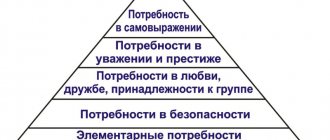In the book by writer Ruth Minshull, How to Choose Your People, you can get acquainted with the Emotional Tone Scale. This idea may seem not only very interesting and sensible, but also practically useful. No matter how different people’s characters may be, no matter how unique each person on earth is born, there is something that unites everyone, and these are emotions. People show them all the time.
We react to events in our lives, work, walk down the street or relax with a certain attitude. We respond to other people's actions and communicate, coloring our conversations with the colors of our mood. Even if it seems that our interlocutor is emotionless, this is just an illusion. Perhaps it was the result of a refusal to sincerely express what was going on in the soul. Nevertheless, this person experiences emotions.
"Tones" can be in a musical scale or in an artist's palette. Each is located after the previous one in a certain order. Thus, in a rainbow green will never appear after red, and in music “C” will never appear after “A”.
The range of emotions that can be experienced is very wide, but it is possible to find commonality among this diversity. Emotional tones that do not affect the spiritual life appear one after another, starting from the very bottom of “Apathy” and ending with joyful “Interest” and “Enthusiasm”.
The most harmonious and adapted to life are those who can show the appropriate emotion in response to an appropriate event. These people are “high-tone.” People who are “chronically” stuck in one tone or another show emotions that are not equal to external circumstances. These are “low-tone” scales.
Here we see a man who, in response to a slight push on public transport, rushes at the offender with fists and abuse. Or a man who smiles guiltily, timidly pointing out to the seller that he has shortchanged him. The company is having fun, but one of the guys sits in the corner looking bored and offended, although no one even tried to offend him. “You had a wonderful dinner!” - the man admires, leaving the hospitable house of the hostess. “Thank you,” she replies, pursing her lips with such irritation, as if this person owes her money.
Alcoholism or drug addiction, chronic fatigue or bad temper - they all have their positions on the scale. To heal, a person needs to experience the next emotion in order and not stop, striving for joy, peace and active interest in his life. We - friends and relatives - can help him with this. To do this, it is enough to accept the emotion and rise upward together. If a person cries, there is no need to assure him that life is wonderful, he is not able to appreciate it. Let him cry, take pity on him, show him that you accept his grief and feel his pain. And when the tears dry up and the person calms down, showing interest in life, you can gently help him believe in prospects and future joy.
A chronic position on the scale, if a person does not want to change, fills each emotional tone with a certain set of actions. This helps us imagine what we can expect from a person when we recognize his portrait on the scale. So, now it's time to familiarize yourself with the scale in more detail.
Tone scale:
Emotion scale
L. Ron Hubbard's emotional tone scale allows you to determine the degree of saturation of the human body with the energy of life. This or that dominant emotion manifesting itself in behavior indicates the degree of his creative spirit, and may become a harbinger of future diseases.
Here, the zero mark corresponding to the state of death is taken as the basis (of course, this means mental death, although it often becomes a harbinger of biological death). Further in the table, the spectrum of emotions is described in increasing order: at the very bottom, negative and pathogenic, as they increase, they gradually sublimate in their manifestation. Thus, apathy and fear at the very bottom are replaced by anger and aggression, then a state of boredom and satisfaction sets in, in which interest and enthusiasm can awaken. There are also levels higher than enthusiasm, but an ordinary person, as a rule, does not “reach” them in his emotions.
The emotional state of all people is characterized by a certain level of this scale, constantly balancing on the “alive - dead” scales. There are very few who are completely alive, but there is an abundance of “almost dead”.
The general table of emotions looks like this:
40.0 Serenity of existence 30.0 Postulates 22.0 Games 20.0 Action 8.0 Delight 6.0 Aesthetics 4.0 Enthusiasm 3.5 Joy 3.3 Strong interest
3.0 Conservatism 2.9 Moderate interest 2.8 Satisfaction 2.6 Disinterest 2.5 Boredom 2.4 Monotony
2.0 Antagonism 1.9 Hostility 1.8 Pain 1.5 Anger 1.4 Hatred 1.3 Resentment 1.2 Lack of empathy 1.15 Unspoken resentment 1.1 Hidden hostility 1.02 Anxiety
1.0 Fear 0.98 Despair 0.96 Horror 0.94 Numbness 0.9 Sympathy 0.8 Appeasement 0.5 Grief 0.375 Redemption 0.3 Undeserving 0.2 Self-deprecation 0.1 Victim 0.07 Hopelessness 0.05 Apathy 0.03 Uselessness 0.01 Dying 0.0 Death of the body
Knowing the scale of emotional tones allows you to better understand the background of other people's behavior. This table has an expanded form, characterizing, depending on the emotional state, the ethical level, state of health and predisposition to illness, personal and business qualities, reliability, success, state of things (!), etc. It is obviously correct to state that the emotional background is a visible manifestation of a person’s internal state.
People at the bottom of the scale attract failure and are unreliable in business. As one slides down to “zero,” the degree of suggestibility of a person increases, which is what all kinds of manipulators take advantage of. As we approach the level of death, the number of chronic diseases increases (which is natural) and pathological character traits appear. The tendency to betray, for example, is generally characteristic of a state between 0 and 1.
In apathy, a person does not have his own desires, and all his needs are imposed by external influences. Such a person, if nothing happens, can work all his life in some place and feel good in the general flow: go to the office, to the store, to the dacha, to go to resorts at a set time... But he is unable to grow a business, the risk and will never take on any obligations. If you want to get someone to take a constructive approach, it is useless to do so when they are at the bottom of the emotional scale. In this state, he is so closed from the world that he is unlikely to hear you. First, you must definitely raise his internal tone to the highest possible level and only after that demand something from him.
Now most people are in a state of apathy . This is considered to be stability, which is an extremely dangerous delusion. Because everything here is filled with the poison of hypocrisy and an atmosphere of fear, when they say one thing and do another, while many among the masses have a tendency to deception and betrayal. And it is from this state that spontaneous and unexpected outbursts of aggression follow. There are only two ways out of it: down - into the dying phase and up - into conscious aggression and then into “boredom”.
Anger is a moment of self-awareness by a person. At some point he begins to realize that he has desires. And that they do not quite coincide (and sometimes do not coincide at all) with the prevailing environmental conventions. Such a contradiction gives rise to internal aggression, as a manifestation of its own “engine”. A person learns to oppose himself to the environment, set goals, overcome obstacles and suffer defeats... In general, it’s not for nothing that they say: in order to achieve something, you must first get really angry. Just not at the unlucky person, but at the problem that has arisen (or, as the shamans say, to declare a hunt for it). Any situation, even the most old one, can be shaken in this way. This gains invaluable experience for a future qualitative leap in the awareness of reality. If you have any business, it is better with the evil ones, because... such people are at least predictable and in this respect reliable.
Boredom is a level higher than anger. Understanding the imperfection of the environment, a person stops reacting emotionally to it as meaningless. It is extremely important to distinguish this state from apathy, since there is complete lack of will, but here, on the contrary, there is energy to achieve a goal, simply without unnecessary negative sensory content. Boredom is a state of stability and contentment. This is what many people limit their lives to, considering it a certain standard of their achievements.
Joy. Like euphoria from some achievement, success, etc. this feeling does not yet indicate complete mental competence (although, of course, it is immeasurably higher than those lower on the scale). It’s just that a person is used to looking for a reason to be happy (for example, holidays, anniversaries, etc.). And for example, children up to a certain age simply live in a state of natural joy from the feeling that they exist. And they do not separate this emotion from themselves - this is their natural way of existing. Then it gets clogged with upbringing, which is why a person loses many opportunities. After all, it is clear that only in such a state is real creativity possible. And this is a sign of true mental health.
The level of feeling of life flow, satisfaction from the very process of life (according to Hubbard, “enthusiasm”, but I don’t like this word) is even higher. In this state, a strong person perceives external blows as a contrast shower, beneficial for health and energizing. But this is a separate topic, since for the vast majority of people this is out of reach.
Conditions characterized by the upper part of the scale, unfortunately, are available only to a few from the general mass. Such people can stand out for their charisma and become informal leaders and centers of influence, fulfilling some voluntarily undertaken mission, despite the fact that the concerns of ordinary people concern them little, and all their attention is occupied by some significant goal that goes far beyond the ordinary.
If we take into account that all manifestations of the psyche up to the 4th level are, in general, a painful state, then we must admit that the vast majority of the planet's population is mentally ill in a deeply inveterate form. And there is a huge problem that this sluggish stagnation has become the norm of life: television series, news collections, product advertising and other means of manipulating mass consciousness are adjusted to it.
There is no doubt that Hubbard began his studies with the foundations of Buddhism (since almost all Western schools associated with deep immersion in consciousness have roots there). Then we can make the assumption that nirvana is a feeling of complete mental health. It is usually customary to mean by the word “peace” a kind of rest - although it is quite possible that this is a level of complete internal balance and self-sufficiency. Then it turns out that Nirvana (according to Hubbard scale No. 40) is the reference state for super-efforts, super-actions and unusual achievements at the level of a miracle.
You can’t jump straight from the dustbin into holiness. Giving up desires while maintaining the fullness of life is a very high level that must be gradually approached. First, you need to very well formulate and realize your own desires. This is how the understanding and feeling of what is called “Azm am” (“I am what I am” or “I exist!”) gradually awakens.
Sublimation and raising vibrations
The method with emotional tones is very simple and has shown its complete reliability in practice. Moreover, it would be very useful to introduce such an in-depth understanding of another person from the point of view of emotions at school during ethics lessons. Then there would be fewer unfounded grievances and tragedies, relations between people would be smoother.
The emotional tone scale has nothing to do with mentality. And this is yet another piece of evidence that man did not appear randomly from a chaotic set of different ingredients (then other qualities would have won, for example, caring for offspring), but was constructed according to some design as a super-complex biological machine.
Tone Scale Position
Knowing a person's position on this scale can tell a lot about his attitude toward things, his behavior, and his survival potential.
From 0.05 to 2.0
When a person is close to death, we can say that he is in a state of chronic apathy. And he behaves in a certain way. This is 0.05 on the Tone Scale chart.
When a person constantly grieves because of his losses, then he is in grief. And again it behaves in a predictable way. This is 0.5 on the Tone Scale.
When a person has not yet descended on the Tone Scale to the level of grief, but understands that the threat of loss hangs over him, then we can say that he is in the tone of fear. This is the 1.0 tone region on the Tone Scale.
At a level just above fear, past or possible losses give rise to hatred in a person. He, however, does not dare to express it openly, so hatred is expressed secretly. This is tone 1.1 - hidden hostility.
A person who struggles with the threat of loss is angry. He also exhibits other predictable aspects of behavior. This is 1.5.
When a person only suspects that a loss may occur, or he is “stuck” at this level, he becomes indignant. He is in antagonism. This is 2.0 on the scale.
From 2.0 to 4.0
At a level above antagonism, the person's condition is not yet good enough to experience enthusiasm, but not so bad as to experience indignation. The person has lost some goals and at the moment cannot find new ones. He may be said to be bored, or at level 2.5 on the Tone Scale.
Level 3.0
on the Tone Scale chart is conservatism. A person approaches life cautiously, but achieves his goals.
Level 4.0
on the Tone Scale - enthusiasm. The person is happy and full of vitality.
Only a few people are naturally 4.0. Without judging strictly, we can say that the average tone of people is about 2.8.
Difference between “acute” and chronic tones
A person can remain at a certain level of the Tone Scale for a very long time (chronic tone) or for a very short time (instant or “acute” tone). A person can go down the scale under the influence of something, stay in a lower tone for ten minutes and return to a high level again. Or some influence can lower a person’s tone for a period of ten years, and he will never rise.
A person who has experienced too much loss and too much pain tends to fixate on one of the lower levels of the Tone Scale. Its deviations from this level are very minor and short-lived. Therefore, his daily behavior will correspond to this level of the Tone Scale.










